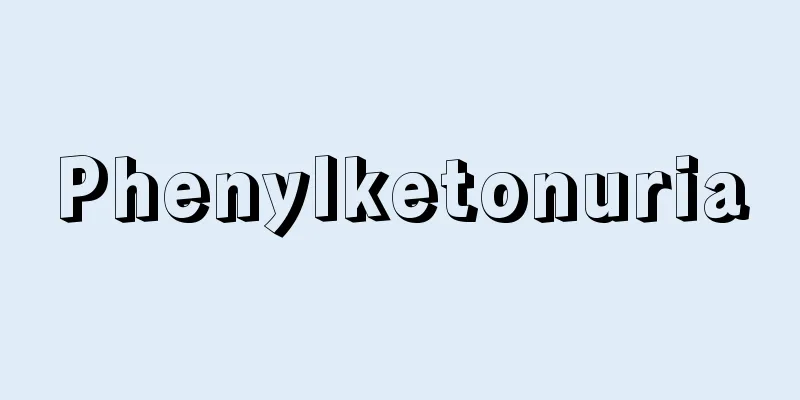Phenylketonuria

|
[What kind of disease is it?] This disease is inherited as an autosomal recessive disorder in which the amino acid phenylalanine (a component of proteins synthesized in the body) is not metabolized and accumulates in the body. When phenylalanine accumulates in the body, a substance called phenylketone is excreted in the urine, hence the name of the disease. Phenylalanine is converted to tyrosine in the liver by phenylalanine hydroxylase, but because this enzyme is congenitally absent, phenylalanine is not converted to tyrosine and accumulates in the body. If left untreated, the condition can stunt intellectual development, possibly because the accumulation of phenylalanine disrupts the balance of amino acids in the body, adversely affecting the maturation of a child's brain. In Japan, the disease is detected in 1 in 100,000 people through newborn mass screening, but in Germany and Ireland the frequency is 1 in 5,000. [Symptoms] During the newborn period, there are no symptoms at all. Accumulated phenylalanine also inhibits the synthesis of a pigment called melanin, so if treatment is not started, the baby will develop a melanin deficiency, and within a few months of birth, the hair will turn reddish-brown and the skin will become pale. Convulsions, a body odor similar to mouse urine, and difficult-to-heal eczema will also appear. At around 6 months of age, development begins to slow, and by the age of 1, the developmental quotient drops to around 50. Treatment begun within the first month of life can prevent these disorders. [Testing and diagnosis] The first step in diagnosis is to measure the amount of phenylalanine in the blood. When the value is higher than the standard value, in order to distinguish it from tetrahydrobiopterin deficiency (column "Tetrahydrobiopterin deficiency"), changes in the amount of phenylalanine in the blood are examined using tetrabiopterin or tetrahydrobiopterin-related substances are analyzed. [Treatment] The basis of treatment is a diet that restricts phenylalanine and keeps blood levels low. However, since phenylalanine is an essential amino acid that cannot be synthesized in the body and must be supplemented by ingesting foods that contain it, the diet should include an appropriate amount of natural protein. The diet should maintain phenylalanine levels at 2-4 mg per dL of blood for infants and toddlers, 3-6 mg for early elementary school children, 3-8 mg for late elementary school children, 3-10 mg for junior high school students, and 3-15 mg for those older than that (the level for healthy children is around 1 mg). The goal of health care treatment is to allow a child to reach adulthood without compromising their innate intellectual abilities. To achieve this, proper dietary therapy is necessary. It is important that families, doctors, nutritionists, etc. work together to guide and educate children so that they understand and accept the disease. A "PKU Parents' Association" has been organized to help and encourage parents of children with phenylketonuria, exchange ideas, ideas, and information, and deepen friendships. Source: Shogakukan Home Medical Library Information |
|
[どんな病気か] フェニルアラニンというアミノ酸(体内で合成されるたんぱく質の材料)が代謝(たいしゃ)されず、体内にたまる病気で、常染色体劣性遺伝(じょうせんしょくたいれっせいいでん)します。フェニルアラニンが体内にたまると、フェニルケトンという物質が尿に排泄(はいせつ)されるようになるので、この病名がついています。 フェニルアラニンは、フェニルアラニン水酸化酵素(すいさんかこうそ)によって、肝臓でチロジンにつくり変えられるのですが、この酵素の作用が生まれつき欠けているために、チロジンに変換されず、フェニルアラニンが体内にたまるのです。 この病気を治療しないでいると、知能の発育が妨げられます。これは、フェニルアラニンの蓄積が、体内のアミノ酸のバランスを乱し、子どもの脳の成熟に悪影響を与えるためと考えられています。 日本では、新生児マススクリーニングで10万人に1人の割合で発見されますが、ドイツやアイルランドでは、5000人に1人という頻度です。 [症状] 新生児期には、まったく症状が現われません。 蓄積したフェニルアラニンは、メラニンという色素の合成も抑制するので、治療を開始しないでいると、メラニンが欠乏し、生後数か月ごろから毛髪が赤茶色になり、皮膚が色白になります。けいれん、ネズミの尿に似た体臭、治りにくい湿疹(しっしん)も現われてきます。 生後6か月ごろになると、発達が遅れるようになり、1歳ごろには、発達指数が50前後にまで下がります。 生後1か月以内に治療を開始すれば、こうした障害を防止できます。 [検査と診断] 血液中のフェニルアラニンの量の測定が診断の第一歩です。値が基準値よりも高いときは、テトラヒドロビオプテリン欠乏症(けつぼうしょう)(コラム「テトラヒドロビオプテリン欠乏症」)と見分けるために、テトラビオプテリンを使って血液中のフェニルアラニンの量の変化を調べたり、テトラヒドロビオプテリンの関連物質の分析を行なったりします。 [治療] フェニルアラニンを制限した食事にし、血液中の値を低く保つのが治療の基本です。ただし、フェニルアラニンは体内で合成できず、これを含む食品を摂取して補わなければならない必須(ひっす)アミノ酸(さん)の1つなので、必要量にみあった自然たんぱく質を加えた食事にします。 フェニルアラニンの値を、血液1dℓ中、乳児から幼児にかけては2~4mg、小学生前半で3~6mg、小学生後半で3~8mg、中学生で3~10mg、それ以降は3~15mgを維持する食事内容にします(健康な子どもの値は1mg前後)。 ●養生 治療目標は、もって生まれた知的能力を損なわずに成人させることです。そのためには、正しい食事療法を行なうことが必要です。 家族、医師、栄養士などが一体となって、子どもに病気のことを理解させ、受け入れさせるように指導・教育することがたいせつです。フェニルケトン尿症の子をもつ親どうしが助け合い、励まし合いながら、知恵、工夫、情報を交換し、親睦(しんぼく)を深める親の会「PKU親の会」が組織されています。 出典 小学館家庭医学館について 情報 |
<<: Phenylacetic acid - Phenylsuccinate
Recommend
Aurelius Prudentius Clemens
The greatest Christian Latin poet since 348-405. B...
Deparia petersenii (English spelling) Depariapetersenii
…[Masahiro Kato]. . . *Some of the terminology th...
Energy balance
→Energy balance Source: Asakura Publishing Nutriti...
Edo
An impure world full of impurity. In Buddhism, it...
Ryoshi
Historical work. One of the 25 official histories ...
Roller, A. (English spelling) RollerA
…He served as conductor at opera houses in Kassel...
Buxbaumia aphylla Hedw.
A moss of the family Cladophyceae with extremely d...
Intermediate - Intermediate
...Three more types were added in the Bronze Age:...
Flavius Valentinianus II
371‐392 Roman Emperor. Reigned 375-392. Son of Val...
Boronia (English spelling)
A general term for the genus Boronia in the family...
Noeggerathiopsis
... The Gondwana continent is characterized by th...
Koussevitzky
An American conductor and composer of Russian orig...
Watercress - Watercress (English spelling)
A perennial plant of the Brassicaceae family (APG...
pyknolepsy
...During a tonic seizure, the EEG shows a genera...
Tashauz
The population is concentrated along the rivers a...





![Nagaland [State] (English spelling)](/upload/images/67cc652eee2b5.webp)



